By the time the leaves began to turn this fall, Canada’s climate promises had already started to wither.
Since Prime Minister Mark Carney took office, the new federal government has in recent months gone on to repeal the carbon price for big polluters. It has paused the electric vehicle (EV) mandate and renewed public financing for fossil fuel exports under the guise of ‘economic security.’ It promised new liquefied natural gas (LNG) investments, cuts to federal programs and record military spending, all while deadly and record-setting heatwaves, droughts and floods swept the country.
So on September 20th, tens of thousands of people across Canada drew the line. This global day of action united voices across continents in defiance of governments that subsidize destruction and call it progress, all while the earth burns.
Here at home, Canadians gathered with one shared vision — for people, for peace and for the planet — and sent a clear message to Ottawa that they refused to let profit and politics outweigh a livable future for all. More than seventy Draw the Line actions took place from coast to coast, part of a powerful coalition effort led by national partners across the labour, migrant justice, peace and climate movements (including Climate Reality Project Canada!).
For our Community Climate Hubs, Draw the Line was a continuation of the long work of organizing, educating and building local power. It was also a moment to affirm that climate action cannot be siloed as they took the streets alongside movements whose struggles are interlinked with the very same systems driving the climate crisis.
Scroll to explore highlights from how some of our Hubs across the country drew the line!
British Columbia
Vancouver Island
On Vancouver Island, over 150 people gathered in Duncan’s City Square as the square came alive with music, conversation and banners calling for justice. The gathering grew from a shared decision to stay local rather than travel to the larger rallies in Nanaimo or Victoria. As organizers put it, building common cause in their own community was more valuable than swelling the numbers elsewhere.
As a result, several local groups — among them the Cowichan Climate Hub, the Freedom from War Coalition and Revolve Cowichan — created space for neighbours to learn, connect and imagine a better future for the Cowichan Valley. Posters went up across the valley, local papers covered the event in advance, and by the time the music had started, the square was starting to rapidly fill up.
After a land acknowledgement recognizing the Quw’utsun people and their ancestral unceded territory — land they’ve stewarded for generations — those present were asked to affirm their collective responsibility to respect Indigenous rights, Indigenous land and Indigenous-led stewardship, and to pledge to work together toward climate justice and environmental protection. Between songs about changing the world, speakers on stage went on to denounce “regressive moves by North Cowichan council, where several councillors deny anthropogenic climate change and have voted to reverse progressive climate policies,” as well as "the municipality's decision to log the Six Mountains,” a choice that has strained relationships with local Cowichan Tribes. Others raised alarms about growing violence toward unhoused residents and the scapegoating of transgender people, immigrants, Indigenous peoples and disabled community members.
“A great day, enthusiast crowd, the rain held off and we’ve created more potential for partnering with each other in the future!” the Hub concludes.
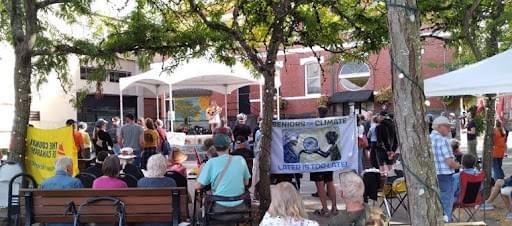
Over 150 people gathered in Duncan’s City Square as the square came alive with music, conversation and banners calling for justice.
Nanaimo
Ahead of the national action, the Nanaimo Climate Action Hub’s Climate Connections Summit brought people together to explore how local communities can take meaningful action on the climate emergency. An art build allowed participants to create banners and materials for the rally on September 20, turning abstract demands into creative expressions of resistance.
Draw the Line organizer Mia Jongkind notes that roughly 150 people attended the rally co-organized by Seniors for Climate and Council of Canadians Nanaimo and heavily supported by the Nanaimo Hub. Volunteers handed out about 200 homemade cookies, a small gesture that underscored the importance of nourishing relationships within movements, because drawing the line means showing up for each other as much as it means showing up for the planet.
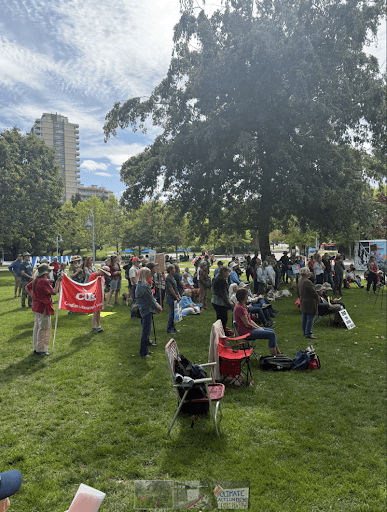
Roughly 150 people attended the rally co-organized by Seniors for Climate and Council of Canadians Nanaimo and heavily supported by the Nanaimo Hub.
Interior BC
In the West Kootenays, over 150 people came together to make their voices heard, proving that even smaller towns can make big demands. In Castlegar, for instance, the West Kootenay Climate Hub worked alongside organizations such as Seniors for Climate to host a lively gathering where attendees made signs, shared stories and listened to speakers who connected local concerns to global crises. The day was about showing that climate justice can be joyful, inclusive and intergenerational.
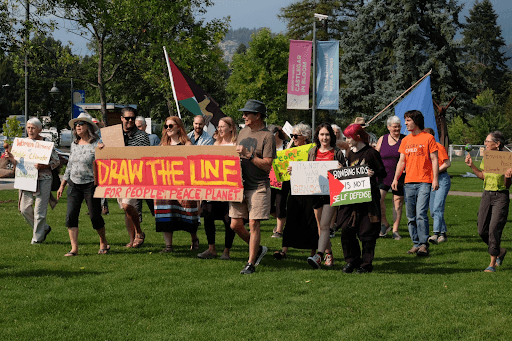
People came together to make their voices heard in Castlegar.
Meanwhile, in Nelson, Kootenay Lakes Seniors for Climate and the Nelson Council of Canadians chapter — partner organizations of the West Kootenay Climate Hub — blended creativity and tradition as participants marched through the Harvest Market, their “ugly stick” noise makers echoing through the streets. Banners waved, chants rang out and the crowd’s energy culminated in a rally where speakers reminded everyone that every small action contributes to a global movement for justice.
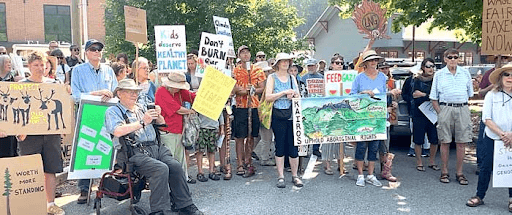
Participants marched through the Harvest Market in Nelson.
The Prairies
Calgary
In Calgary, the Draw the Line action was a vivid example of how our struggles are inseparable. Speakers from the Calgary Climate Hub, Migrante Alberta, Calgary Justice for Palestinians and CUPE Alberta reminded over 350 attendees that the crises we face are not isolated; they compound, intersect and demand equally interconnected responses.
Jared Blustein (Executive Director, Calgary Climate Hub) insists that “we refuse to stand by while the government and Canada's richest corporations hoard wealth, gut our public services, fuel climate collapse, attack migrants, exploit Indigenous lands, and profit off needless war, the most recent being the current genocide in Palestine. And we recognize the threads of power and profit that weave all of these issues together.
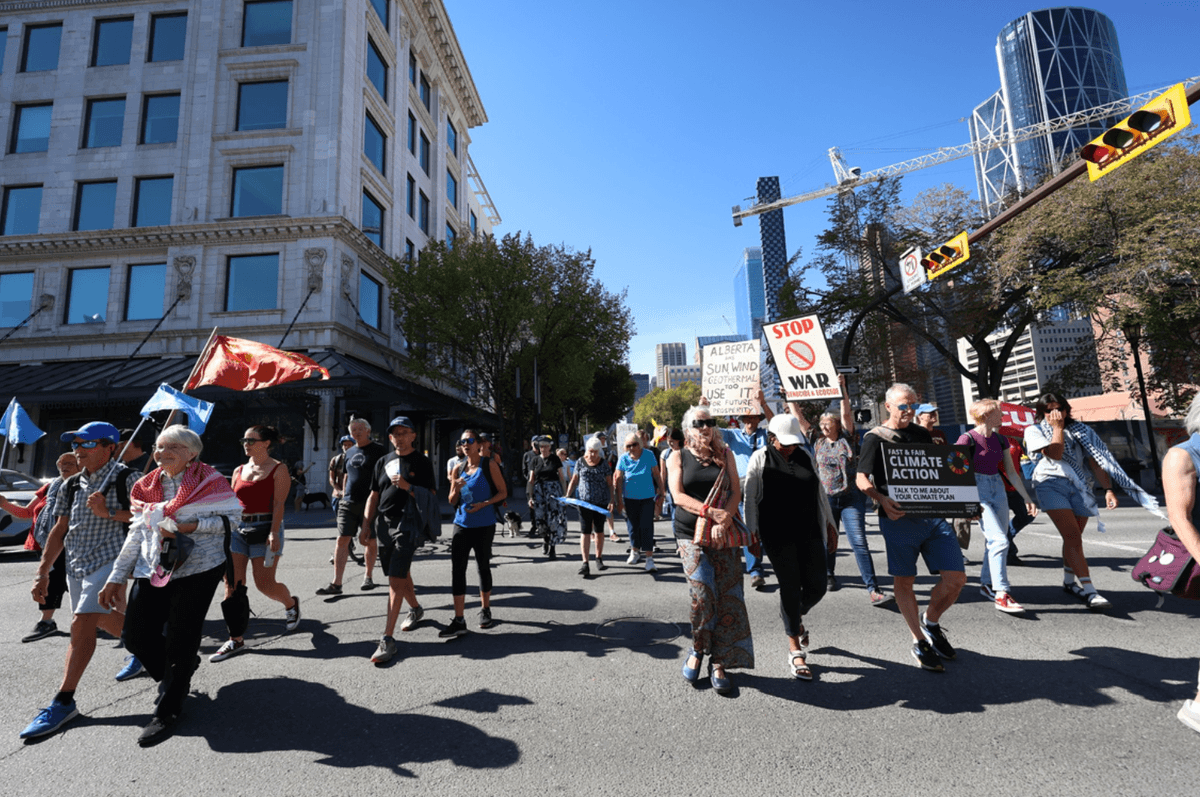
Over 350 attendees attended the Draw the Line action in Calgary.
Saskatoon
Saskatoon pulsed with the energy of between 100 to 140 people marching and chanting. Climate Justice Saskatoon led the rally, with the Saskatoon Climate Hub stepping in as a supporter, helping to connect this local action to the broader national movement.
What was unmistakable was a sense of collective hope and determination that justice, peace and a sustainable future are all possible. As Glenn Wright (organizer, Climate Justice Saskatoon) notes: "love motivates people to change and make a difference. Around the world today many people have stood up to draw the line and their presence demonstrates our collective empathy, concern and awakening. We have the power to change – but that change begins in our minds."
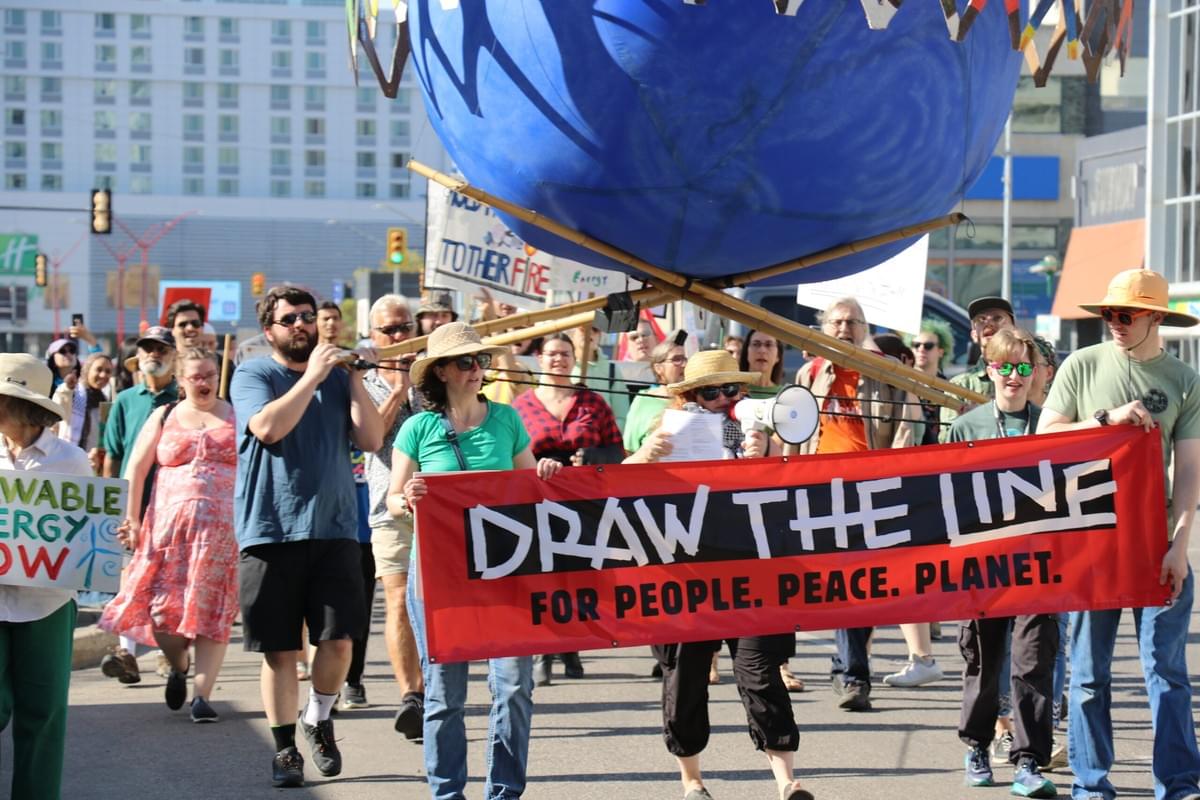
Saskatoon pulsed with the energy of between 100 to 140 people marching and chanting. Photo credits to Climate Justice Saskatoon.
Winnipeg
“We are DONE with our tax dollars spent on militarism. We are fed up with anti-Indigenous, anti-migrant, anti-Palestine and fossil fuel-driven policy. We need nation-building projects that enrich the land, the water and the air and the people.”
These are the words of the Manitoba Climate Action Team (MCAT), who joined the Manitoba Energy Justice Coalition (MEJC) and over a dozen local organizations to make their voices heard in Winnipeg after a summer of record-breaking wildfires. More than 400 people braved the rain outside Premier Wab Kinew’s constituency office, united in their demand for stronger climate action and government accountability.
The organizers delivered MEJC’s Power Up petition — calling for investment in solar, wind and energy efficiency, along with a phase-out of natural gas — and posted the more than 1,000 signatories on the Premier’s office. “We hope he remembers that he works for the people who elected him, and we know he can do better!” adds the Hub.
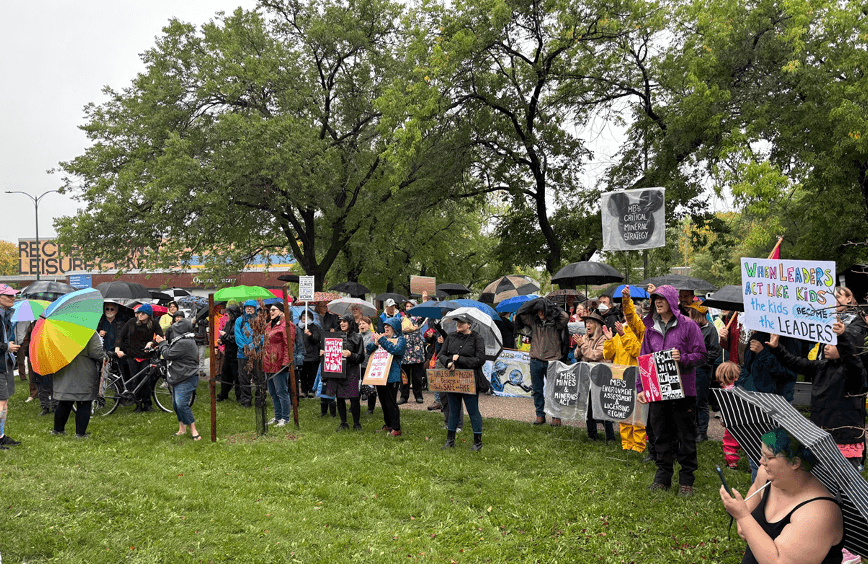
More than 400 people braved the rain outside Premier Wab Kinew’s constituency office.
Central and Atlantic Canada
Ottawa
The nation’s capital was where hundreds gathered to make their message unmistakable. Although there were no Hub-led actions in Ottawa, members of the Climate Reality Canada team joined more than 70 groups in person — beginning outside the Prime Minister’s Office — to march shoulder to shoulder in solidarity with hundreds calling for peace, justice and climate leadership. Chants such as “when they don’t enforce emissions caps for big oil, that’s where we draw the line!” echoed through the streets.
A number of activists created a 65-metre-long mural with washable paint directly on Wellington Street as part of a bold act of civil disobedience. The massive artwork read “People peace planet not profit” and featured symbols such as a moose, fish, a person holding a feather, butterflies and a watermelon — each representing the diverse issues at the heart of the movement.
“We are drawing the line at Prime Minister Mark Carney’s doorstop,” exclaimed Draw the Line organizer Katie Perfitt. “We are refusing to let the government continue down a path of climate destruction, militarism and scapegoating of migrants.”
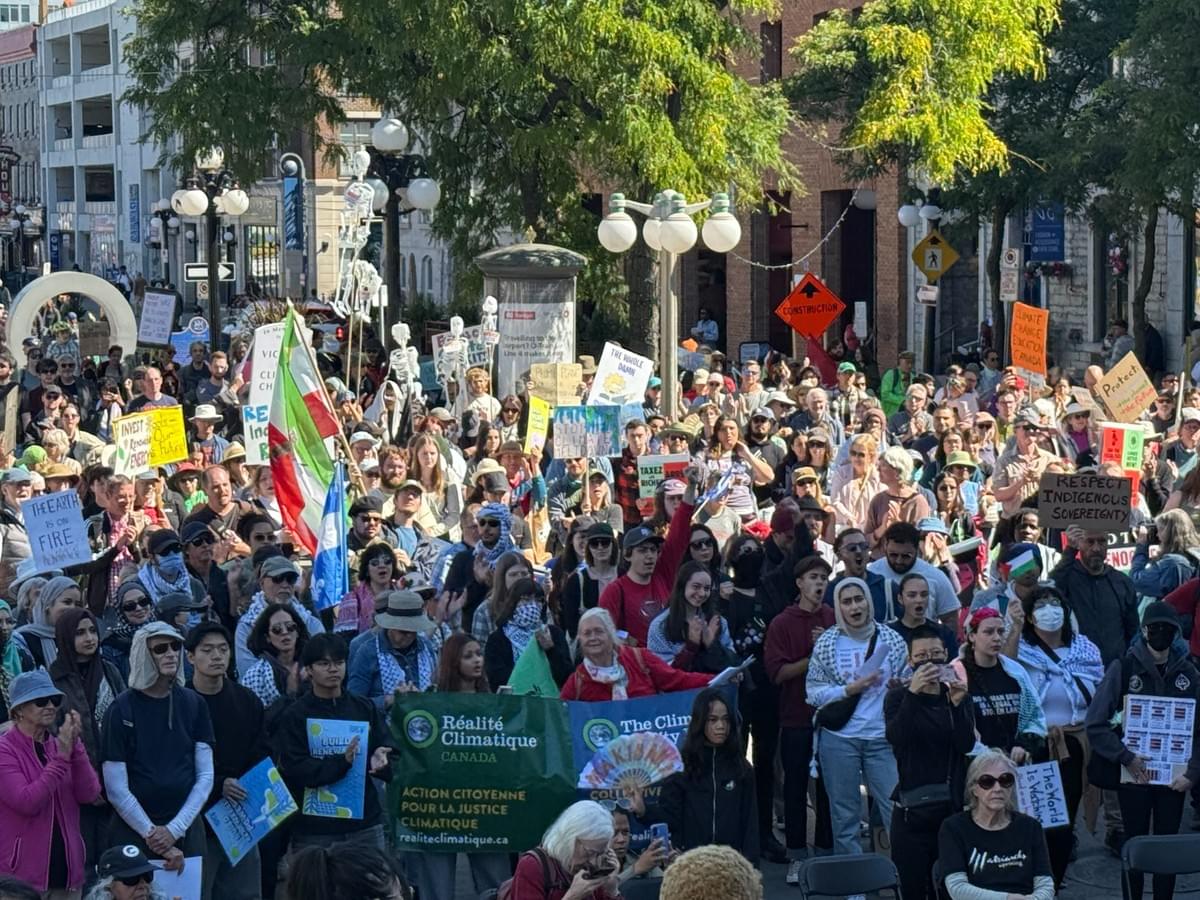
Members of the Climate Reality Canada team joined more than 70 groups in person.
Peterborough
In Peterborough, For Our Grandchildren chose a different way to draw the line. When no local partners stepped up to organize a large rally, the Hub decided to use the weekend as an opportunity to reach beyond their usual circles and strengthen ties with new communities. They set up information booths at the Curve Lake Powwow and the Peterborough Pride festival, engaging passersby in thoughtful conversations about climate justice and local action. Volunteers shared information about ongoing climate initiatives and invited people to take a simple but powerful step by adding their voice to a ‘Ribbon for our Climate Tree.’
“We are very encouraged and pleased by the new relationships we built within communities who share many of our core values for social and climate justice,” the Hub shares, reflecting on the approximately two hundred people who paused to reflect and write down their hopes, frustrations and commitments for the planet’s future. For them, drawing the line necessitates that we build bridges and shared purpose in the fight for a just and livable future.
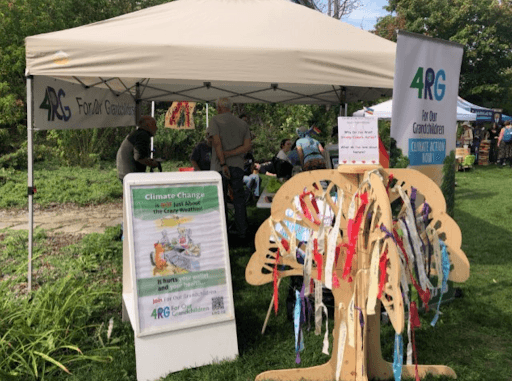
Volunteers added their voice to a ‘Ribbon for our Climate Tree.’
Beyond the line
For our Hubs network, the energy, creativity and solidarity witnessed on September 20 demonstrate that the climate movement is not shrinking under political pressure. Rather, it’s evolving, becoming intersectional and deeply democratic.
This September 20th, Canadians demonstrated that true climate justice lives in our relationships with one another, with the land and with every movement demanding dignity and peace.
This is because, ultimately, the climate crisis is not a siloed environmental problem. It’s the consequence of an economic and political system built on decades upon decades of extraction, militarism and inequality.
Every rollback, every privatization, every cut to social and environmental programs is a climate issue. And so every migrant worker exploited, every Indigenous nation’s sovereignty violated, every new pipeline and fighter jet funded is all inherently climate policy.
The ongoing climate crisis we are experiencing is about power, equity and the kind of world we choose to build. The same systems that exploit land and water also exploit people, and the same forces that drive war and displacement drive the extraction and profit-seeking that heat our planet. To confront these crises, our movements must stand together.
Draw the Line represented a vision of solidarity in action, where communities refuse to be divided and where hope becomes a practice. As our Hubs continue their work in the months ahead — engaging municipal councils, supporting grassroots organizing, nurturing relationships — they carry forward this lesson that real climate action is collective action. And from these local seeds being planted, a new story is blooming and taking shape. The line we drew together is one from which a new future begins.
Find your local hub or start your own, and let's keep the momentum growing together!